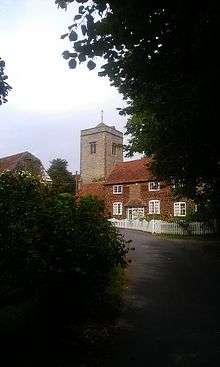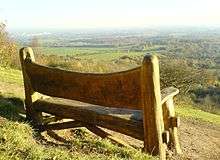Trottiscliffe
| Trottiscliffe | |
 Trottiscliffe |
|
| Population | 485 (2011 Census)[1] |
|---|---|
| OS grid reference | TQ64606052 |
| District | Tonbridge and Malling |
| Shire county | Kent |
| Region | South East |
| Country | England |
| Sovereign state | United Kingdom |
| Post town | West Malling |
| Postcode district | ME19 |
| Dialling code | [01732] |
| Police | Kent |
| Fire | Kent |
| Ambulance | South East Coast |
| EU Parliament | South East England |
| UK Parliament | Tonbridge and Malling |
Coordinates: 51°19′12″N 0°21′39″E / 51.31997°N 0.36072°E
Trottiscliffe (![]() i/ˈtrɒzli/ "Trozli")[2][3] is a village in Kent, England about 2.5 miles (4 km) north west of West Malling.
i/ˈtrɒzli/ "Trozli")[2][3] is a village in Kent, England about 2.5 miles (4 km) north west of West Malling.


Its most notable feature is the neolithic long barrow known as the Coldrum Stones and its medieval church. It is often incorrectly spelled Trosley after Trosley Country Park at the top of the North Downs, which was once part of the Trosley Towers Estate. The spelling Trottesclyve [4] appears with nearby Hallyng in 1396.
Perhaps the best known resident of the village was artist Graham Sutherland who, in 1954, painted a portrait of Sir Winston Churchill. The picture was hated by Churchill, to whom it was presented on his 80th birthday, and was destroyed by his wife, Clementine, shortly after it was taken to Chartwell.
References
- ↑ "Civil Parish population 2011". Neighbourhood Statistics. Office for National Statistics. Retrieved 24 September 2016.
- ↑ Glover, Judith (1976). The Place Names of Kent. Batsford. ISBN 0-905270-61-4.
- ↑ "Trottiscliffe Primary School". Retrieved 2008-02-11.
- ↑ Plea Rolls of the Court of Common Pleas; National Archives. http://aalt.law.uh.edu/AALT6/R2/CP40no541a/bCP40no541adorses/IMG_0721.htm; third entry, end of line 2 - a free warren trespass on lands of the bishop of Rochester
External links
| Wikimedia Commons has media related to Trottiscliffe. |
